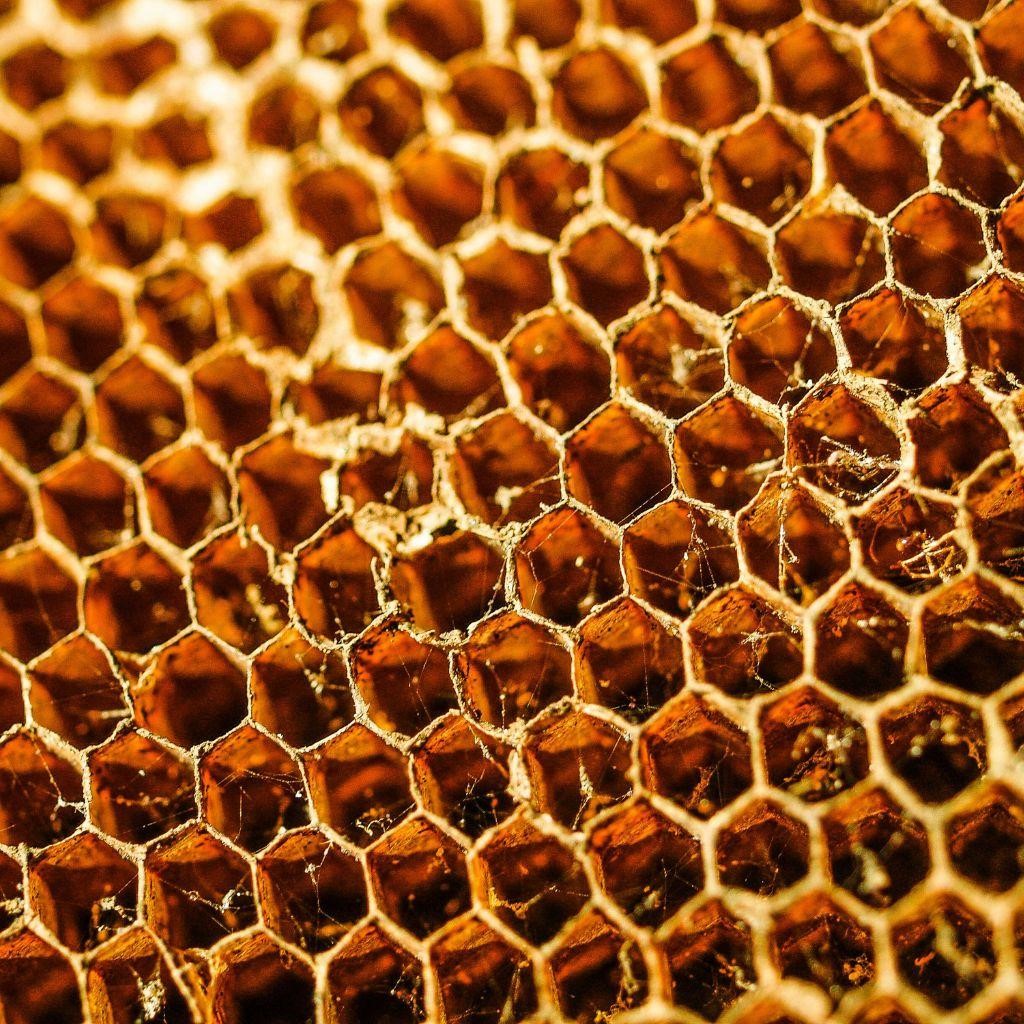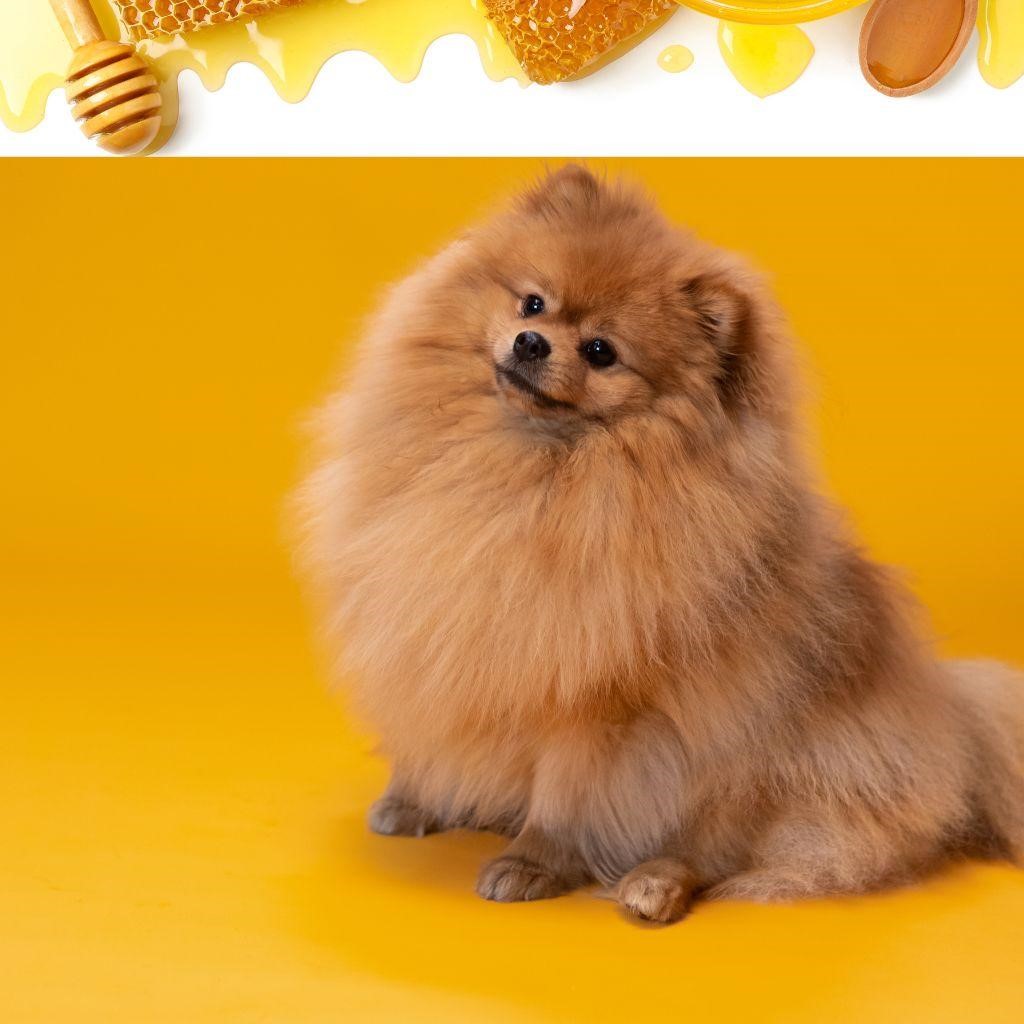Honeycomb is a delicious and healthy treat for humans, but can dogs eat honeycomb? Dogs can eat honeycomb, but only in limited quantities. First, it is crucial to understand that moderate amounts of honey are safe for dogs to consume.
Honeycomb, on the other hand, is a unique case. Dogs’ digestive systems differ from those of humans, and they may have difficulty breaking down and processing the wax.
It might result in digestive issues like diarrhea, Vomiting, and abdominal pain. Furthermore, some honeycombs may include pesticide traces, which can harm dogs.
It is critical to obtain honeycomb from a reliable provider and guarantee it is devoid of dangerous elements.
If you do decide to offer your dog honeycomb as a treat, Start with modest amounts and watch their behavior intently.
Stop administering medication to them immediately if you observe any signs of discomfort or illness and consult with your veterinarian.
What is Honeycomb Made of?

A honeycomb is a beeswax structure formed by honey bees in their hives to store honey, pollen, and larvae.
The honeycomb’s hexagonal cells are ideal for increasing storage capacity while reducing the quantity of wax required to build it.
Honeycomb cells are also arranged in such a way that airflow within the hive is maximized. Honeycomb is a natural product beekeepers harvest for its tasty honey and other health advantages.
Honeycomb is utilized not just as a sweetener and food but also for various medicinal and aesthetic purposes.
Because of its distinctive hexagonal shape and texture, it is often employed in art and design.
Is Honeycomb Healthy For Dogs?

Honey is frequently marketed as a natural sweetener with numerous human health benefits. However the question arises is honeycomb healthy for dogs? Can dogs eat honeycomb?
Honeycomb may provide various health benefits to dogs. Here are some healthy benefits of eating honeycomb:
- Nutritional Value: Vitamin, minerals, and antioxidants are abundant in honeycomb. It provides amino acids that are necessary for muscle growth and repair.
- Soothes Sore Throat: Honeycomb has anti-inflammatory qualities that can help ease a sore throat. Honeycomb can also benefit dogs with coughing and respiratory illnesses.
- Boosts Energy: Honeycomb is a natural glucose source, providing dogs with instant energy. It can be an excellent supplement for energetic dogs or those needing an energy boost.
- Supports Wound Healing: Honeycomb possesses an antibacterial characteristic that can help prevent infections and promote wound healing in dogs. It also has a natural adhesive characteristic that can aid in the adhesion of bandages to wounds.
Risks of Honeycomb for Dogs

Despite the possible benefits of honeycomb, giving it to dogs has some hazards. Here are a few examples:
- Choking Hazard: Honeycomb can be a choking hazard, especially for little dogs or dogs who swallow food without chewing it thoroughly. Before feeding the honeycomb to your dog, chop it into little pieces or crush it.
- Allergic Reactions: Some dogs may have adverse reactions to honeycomb or other bee products. Allergic reactions can produce itching, hives, swelling, and even anaphylaxis, a potentially fatal allergic reaction.
Seek emergency veterinarian attention if your dog exhibits signs of an allergic response, such as difficulty breathing, swelling, or vomiting.
- High Sugar Content: Honeycomb is heavy in sugar and, if ingested in excess, can promote weight gain, teeth damage, and other health concerns in dogs. Honeycomb should be fed to your dog in moderation and as a treat, not a regular part of their diet.
- Botulism: Botulinum spores in honeycomb can cause botulism, a rare yet serious dog sickness. Botulism can induce muscle weakness, paralysis, and respiratory failure. However, if the honeycomb is new and not contaminated, the danger of botulism is negligible.
Can Dogs Eat Honey?

Yes, dogs can eat honey but in small amount. Honey is generally safe for dogs and may even provide some health benefits, such as boosting their immune system and providing natural energy.
However, because honey contains a lot of sugar and calories, it should only be provided to dogs in small quantities. Excessive honey consumption might result in digestive discomforts, such as diarrhea or vomiting.
If you give your dog honey, be sure it’s pure, raw honey with no added sugars or preservatives.
It’s also beneficial to start slowly and watch your dog for any adverse reaction it is best to contact your veterinarian if you have any concerns or questions regarding providing honey to your dog.
Honeycomb or Honey: Which Is Better for Your Dog’s Health?
|
HONEY |
HONEYCOMB |
|
|
TEXTURE |
Honey has a smooth liquid texture that is easy to pour and blend into your dog’s food or water. |
Honey has a smooth liquid texture that is easy to pour and blend into your dog’s food or water. |
|
CALORIC CONTENT |
Honey is often higher in calories than the honeycomb, so keep an eye on your dog’s portion sizes. |
Both honey and honeycomb are abundant in calories and natural sugars, which, if eaten in excess, may give rise to weight gain and other health problems |
|
DIGESTIBILITY |
Honey, is more easily digested and absorbed. |
Honeycomb contains natural enzymes and probiotics that can improve digestion, some dogs may struggle to digest the waxy texture. |
|
TASTE PREFERENCES |
Some dogs love honey’s sweet taste and smooth texture. |
While others prefer honeycomb’s crunchy texture and distinct flavor. Introducing new foods gradually and observing your dog’s reactions is critical. |
Both honeycomb and honey can be beneficial additions to your dog’s diet, but they must be fed in moderation and with consideration for your dog’s preferences and digestive needs.
If you need clarification on whether honey or honeycomb is safe for your dog, consult your doctor for personalized guidance.
A Sticky Situation: What You Need to Know Before Feeding Your Dog Honeycomb
Feeding honeycomb to your dog can be tricky, but with appropriate preparation and caution, it can be a safe and healthy treat.
When feeding honeycomb to your dog, ensure it’s pure and free of additives, preservatives, or artificial sweeteners.
Remove wax from the honeycomb before feeding it to your dog, which might cause choking.
You should also limit the amount of honeycomb you feed your dog because it is still a type of sugar and, if ingested in excess, can promote weight gain and other health problems.
If your dog has any health issues or is taking medication, consult your veterinarian before introducing honeycomb or any other new food.
You may safely add honeycomb to your dog’s diet and enjoy its many benefits by following these rules.
How much Honeycomb can a Dog Eat?
The amount of honeycomb a dog can consume is determined by size, age, and overall health. While honeycomb has health benefits, it is still a sugar and should be fed to dogs in moderation.
A common rule of thumb is limiting dogs to one teaspoon of honey for 20 pounds of body weight daily.
When offering honeycomb to your dog, practice caution and moderation. You may safely add this natural treat to your dog’s diet by feeding little quantities and watching their reaction.
Honeycomb Allergies in Dogs: Signs, Symptoms, and Treatment
When a dog’s immune system reacts too strongly to the proteins present in honeycomb, he develops a honeycomb allergy.
It can result in symptoms ranging from moderate itching and skin irritation to more serious reactions like difficulty breathing and anaphylaxis.
Honeycomb Allergies in Dogs: Symptoms and Signs
- Honeycomb allergies in dogs: can cause a variety of signs and symptoms, depending on the intensity of the reaction. Some frequent signs and symptoms to look out for are:
- Itching and scratching: If your dog is allergic to honeycomb, it may begin scratching and itching excessively.
- Skin that is red, inflamed, and irritated: Allergic responses can cause the skin to become red, inflamed, and irritated. Hives or welts may also be present in some situations.
- Sneezing and runny nose: If your dog inhales honeycomb particles, it may begin sneezing and have a runny nose. In more difficult situations, dogs may experience vomiting, diarrhea, and other digestive difficulties.
- Breathing difficulties: In rare situations, dogs may develop breathing difficulties, coughing, and wheezing, which can be life-threatening and necessitate emergency medical intervention.
Treatment Options for Dogs with Honeycomb Allergies
If you feel your dog is allergic to honeycomb, immediately get veterinary attention. Your veterinarian can do diagnostic tests to confirm the allergy and advise you on the best treatment options. Some of the most common treatments for honeycomb allergies in dogs include:
Antihistamines: By blocking histamines released by the immune system, antihistamines can help reduce minor allergic reactions. Benadryl and Claritin are two common antihistamines used in dogs.
Steroids: The vet might suggest steroids to reduce inflammation and relieve discomfort if the allergic reaction is severe.
Epinephrine: In rare situations of anaphylaxis, epinephrine is required to assist in opening up airways and improve breathing.
How to Prevent Honeycomb Allergies in Dogs
The easiest strategy to avoid honeycomb allergies in dogs is to avoid giving honeycomb at all.
Instead, gradually use pure honey and introduce new meals to watch your dog’s reactions.
If your dog has a honeycomb allergy, notify family members, friends, and dog sitters so that honeycomb is not given to your dog.
Conclusion
Dogs can consume honeycomb in small amount and reap various health benefits. However, it is essential to be aware of the risks and offer them to your dog in small doses.
If your dog has any health issues or allergies, it is best to contact your veterinarian before introducing any new foods. Always keep your eye on your dog when they are eating honeycomb, and give them lots of fresh water.
